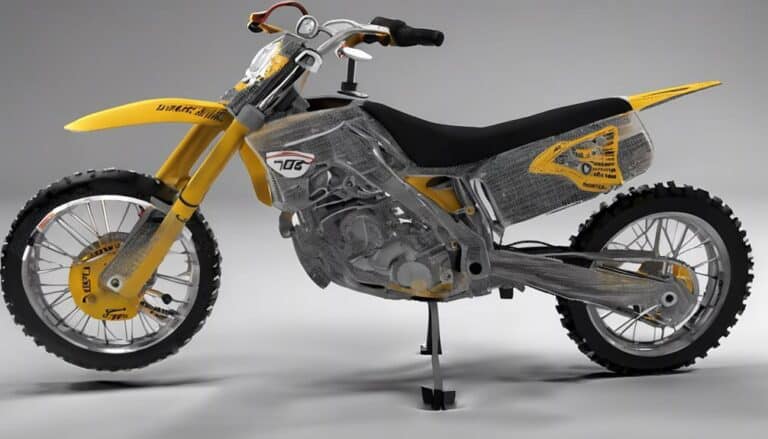Imagine your dirt bike's engine oil as the lifeblood that keeps it running smoothly. Just like a well-oiled machine, your bike requires regular oil changes to function at its best.
But how often should you change the oil to guarantee peak performance and durability? Understanding the recommended maintenance intervals for a dirt bike's oil change is essential for preventing costly damage and maintaining your bike's health.
Let's explore the factors influencing these intervals and how they impact your riding experience.
Key Takeaways
- Follow manufacturer's recommendation: change oil every 15 hours for optimal engine health.
- Consider more frequent changes in harsh conditions to preserve engine performance.
- Monitoring oil quality is crucial; darkened color or low levels indicate the need for maintenance.
- Regular oil changes prevent costly repairs and ensure peak dirt bike operation.
Importance of Regular Oil Changes
Regularly changing your dirt bike's oil is essential for ensuring peak engine health and longevity. The oil in your Dirt Bike plays a critical role in lubricating the engine's moving parts, reducing friction, and carrying away heat.
Over time, oil degrades and becomes contaminated with dirt and debris, leading to increased wear on engine components. By following the manufacturer's recommended maintenance intervals for oil changes, you can maintain peak engine performance and prevent costly repairs.
Fresh oil helps to keep the engine running smoothly, ensuring reliable power delivery and efficiency. Neglecting oil changes can result in poor engine health, decreased longevity, and potential damage that could have been easily prevented. Staying proactive with regular oil changes is a simple yet effective way to protect your Dirt Bike's engine and maximize its lifespan.
Factors Affecting Oil Change Frequency
Shifting from the significance of regular oil changes, comprehending the factors that influence the frequency of oil changes for your dirt bike is essential for maintaining excellent engine health and performance.
Factors affecting oil change frequency include:
- Riding Intensity: The more aggressive you ride, the harder your engine works, potentially requiring more frequent oil changes.
- Weather Conditions: Extreme temperatures and dusty environments can degrade oil faster, necessitating more frequent changes.
- Bike Type: Different dirt bike models may have specific service intervals based on their engine design and performance requirements.
Understanding these factors can help you optimize your oil change schedule to make sure your engine remains well-lubricated and protected. Regularly checking the engine oil level, inspecting the air filter, and using high-quality motor oil are important steps in maintaining your bike's performance and longevity. By staying attentive to these factors, you can prevent unnecessary wear and tear on your engine, enhancing your overall riding experience.
Recommended Oil Change Intervals
For best engine performance and longevity, adhere to the recommended oil change interval of every 15 hours of use for your dirt bike. Following the manufacturer's recommendation is essential in ensuring top performance and reliability.
While some riders may opt for more frequent oil changes, especially under harsh riding conditions, sticking to the 15-hour interval is a solid baseline for most riders. Regular racers often prioritize maintaining their bike's engine health by changing oil more frequently than the recommended interval.
However, the majority of riders find that sticking to 5 to 10-hour oil change intervals strikes a balance between engine health and maintenance costs. By following the suggested maintenance intervals, you can significantly contribute to your dirt bike's engine health and overall performance, ensuring that it operates at its best for a longer period.
Signs Your Dirt Bike Needs an Oil Change
To determine if your dirt bike requires an oil change, observe any darkening of the oil color from brown to black. This change in color indicates the accumulation of dirt and particles, reducing the oil's effectiveness in lubricating the engine.
In addition to the darkening of oil, keep an eye out for low oil levels, which can lead to engine damage if not addressed promptly. Unusual engine noises, such as knocking or grinding sounds, may suggest a lack of proper lubrication, signaling the need for an oil change to prevent potential engine issues.
- Darkening of oil color
- Low oil levels
- Unusual engine noises
Regularly monitoring your dirt bike's oil quality and levels is essential for maintaining engine performance. Ignoring these signs and failing to change the oil when necessary could result in decreased performance and potentially costly engine repairs.
Tips for Proper Oil Change Maintenance
Maintain proper maintenance of your dirt bike's engine by adhering to recommended oil change intervals as specified in the owner's manual. Changing the engine oil every 15 hours of use is advisable to guarantee performance and longevity of your dirt bike engine. Regularly check the oil levels and color to gauge when an oil change is necessary.
In dusty or dirty riding conditions, consider more frequent oil changes to prevent premature engine wear. Following the guidelines outlined in the owner's manual is essential for preserving the health of your dirt bike engine. Remember to change your oil after every few rides or every other ride, depending on usage and environmental factors.
Additionally, inspect and clean the air filter after every ride to maintain proper airflow and engine efficiency. Utilizing tools like a Spoke Torque Wrench can assist in making sure all components are appropriately tightened, contributing to the overall maintenance of your dirt bike.
Conclusion
In summary, maintaining a regular oil change schedule for your dirt bike is essential for optimal performance and longevity.
By following the recommended intervals and paying attention to signs that indicate the need for a change, you can prevent costly engine damage and make sure your bike runs smoothly.
Remember, coinciding your oil changes with your riding hours will help keep your engine in top condition.

